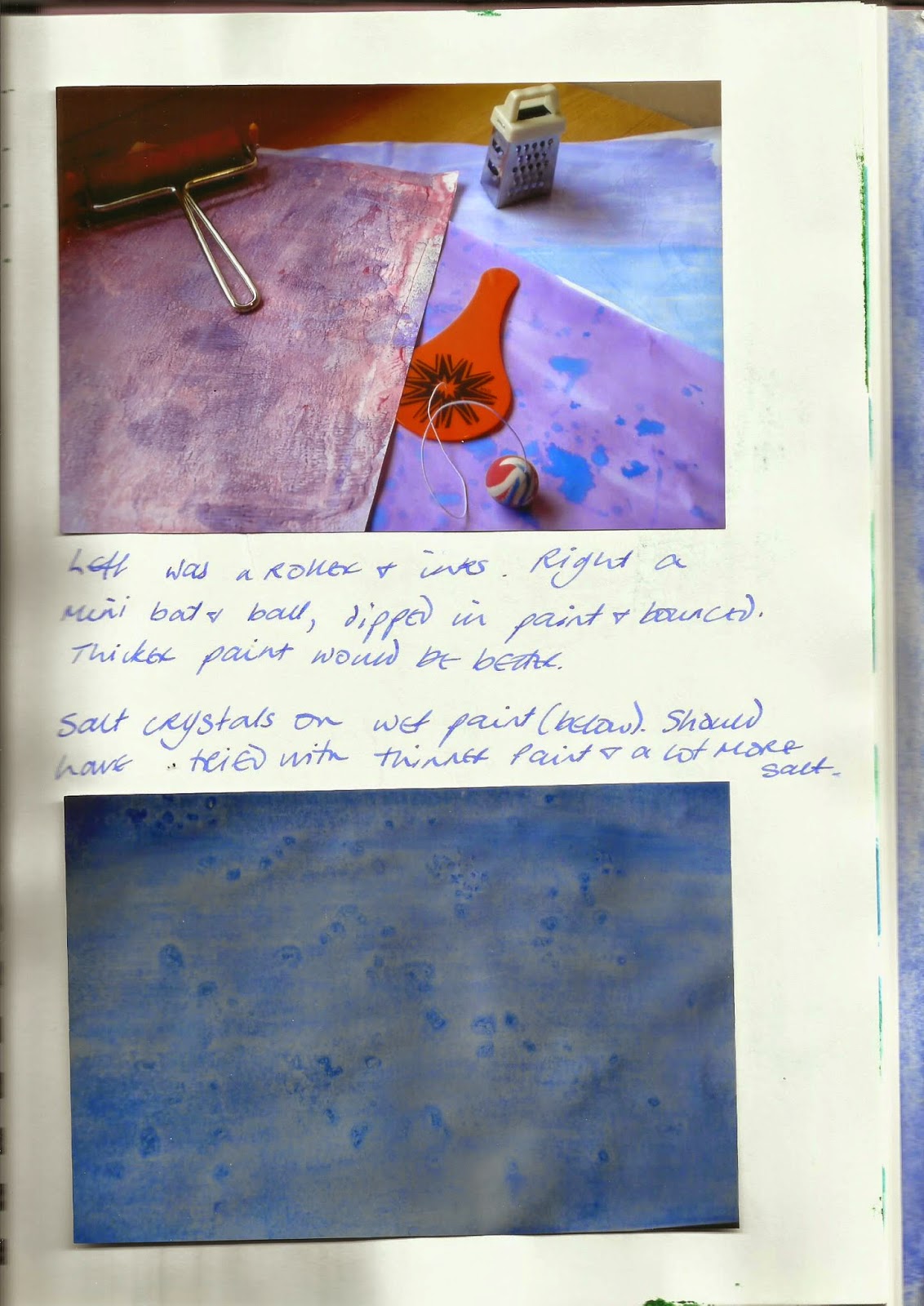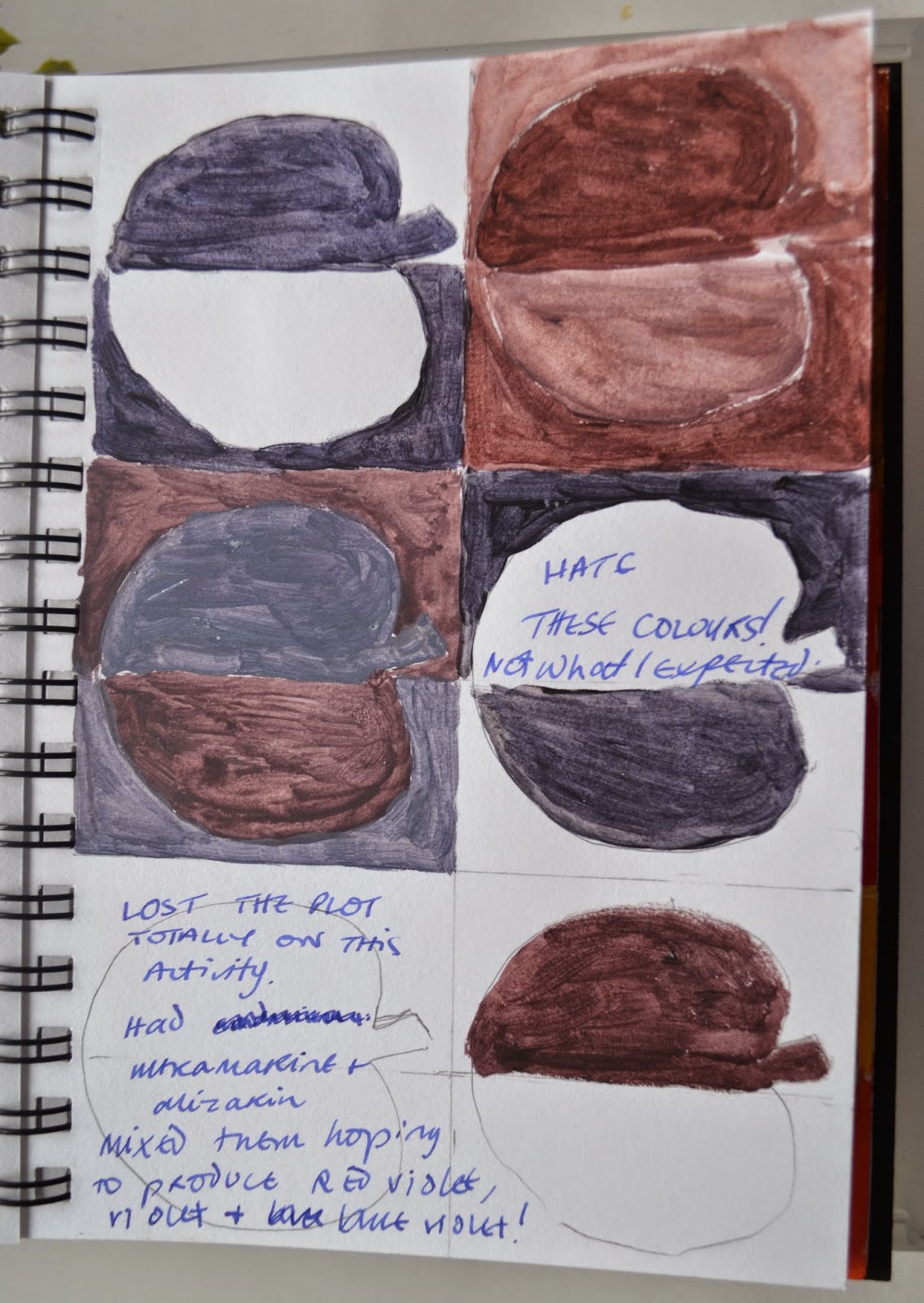Creative Sketchbook, Module 1
Chapter 4,
Activity 4.1, 4.2,
4.3 and Extra Activities
Make decorative
coloured papers using paint.
Somehow, as I worked, one thing led to
another, and I didn’t separate out the various activities in this chapter, but
you can see from the photos that I have covered them.
I scanned in the pages, but the text is difficult to read, so I've pasted it after all the pages. There are a few changes here and there between the sketchbook. 
Right,
this chapter was just what I needed - a real morale booster! It was fabulous,
and I have had such fun, and enjoyed it so much, fiddling around with paper and
paints and implements to make marks with paint…Or in paint! I’ve followed the suggestions in the course
booklet, and experimented with my own ideas (not always successfully, but there
were far more good moments than bad).
Somehow,
as I worked, one thing led to
another, and I didn’t separate out the various activities in this chapter, but
you can see from the photos that I have covered them. I have my decorated
sheets of paper tucked away in a box, and there are far too many to show them
all, so I’ve tried to squeeze as many as possible into photographs, to give some
idea of what I’ve been doing, as well as showing pictures of some individual
sheets. And I’ve written this as a kind of overview, rather than producing
notes about every patterned sheet of paper.
In
a bid to keep some kind of record, I tried to remember to number each piece of
paper, then wrote the number and method on a large label, and stuck that on the
back.
Paints
As
far as paints go, I was reluctant to use my rapidly dwindling stock of
watercolours, so I raided a bag of acrylics
among the stash of arty goodies abandoned by my Elder Daughter when she left
home. The hoard included some huge plastic tubes of cheap acrylics in all sorts
of colours, as well as a range of colours in the usual small tubes. I’ve never really
used acrylics before (apart from my disastrous experiment in Activity in 2.3) so
it was a good opportunity to see how they handle. The big tubes seemed to be
thinner than the small ones, and they were ideal for covering A4 sheets of
paper. They were quick drying and could be used thick (straight from the
tubes), or thinned down with water. They lack the transparent quality of
watercolour, but they mix and merge OK, and thinned down they drip well, and
give interesting effects on the paper. On some papers (shiny, non-porous) thick
acrylics can be moved around to create patterns in the paint, and you can get
textured effects by dragging implements across the surface.
I
bought a set of little pots of children’s poster
paints (because I felt nostalgic after mentioning them in the last
chapter). And, still on a Memory Lane trip, I went online and ordered some powder paints. I hadn’t used either of
these since I was a mum helper in my daughters’ school some 20 years ago, and I’d forgotten how
incredibly messy they can be, but they clean up OK with soap and water. People
are always a bit dismissive of these paints, because they’re seen as being
‘just for children’ but in actual fact they are brilliant for this sort of
project (and they’re dead cheap, which is an advantage) and I loved working
with them. I doubt you could produce fine or subtle effects, but they provide
good cover, and can be used with all kinds of other paints, inks and markers.
Like the acrylics, poster paints can be used just as they are, or thinned down
with water, and they mix and merge and drip and streak and splodge and splatter
and spatter and smudge quite beautifully, and give textured effects. Powder
paints give the same sort of effects when mixed - plus some! Dry powder can be
sieved, dropped, dragged or even blown or spattered across a wet or damp
surface, and you can apply on to dry paper, then spray water over it.
Inks
I’ve
never really used inks before either (other than in my fountain pen, and inked
pads for rubber stamping), but I succumbed to a box of Brusho powders at the embroidery exhibition at the NEC earlier this
year – then got home and was too nervous to use them! So I mixed some up, and
experimented. I discovered a very little powder goes a very long way, so I’m
storing left-overs in foil-covered jam jars. These don’t seem to merge together to form
other colours like paints do, and they are too thin to produce textured
effects, but they are just fabulous brushed or rollered over textured paints,
or other markers, because they are wonderfully transparent. And you can get
incredible effects with them, with a roller, on glossy paper.
Brushes/Applicators
I
mainly used household decorating brushes for covering pages with water, paint, ink
etc, and children’s nylon brushes (round and flat, in a variety of sizes) for
adding details for patterns. I tried using a sponge roller, as suggested in the course book, but was not
impressed. I got much better results with a children’s plastic rolling pin intended for modelling dough, and a Brayer look-alike which is fantastic
(bit tricky to clean though), as was a narrow plastic roller that’s meant to
flatten the edges of wallpaper joins! And I found plastic tools which children use to make marks in modelling dough
are great for making marks in paint. Then there were various bits and bits
found around the house, including plastic
knives and forks – and an old nit
comb (I keep it as a good luck charm because I’m convinced if I throw it
out we’ll be infested with headlice again!).
Markers
I
was going to try using things like pastels, felt tips etc to make marks under
layers of paint or ink, but only got round to using coloured chalk, which works best on dry paper, then water brushed
over the paper, then ink or paint. And little tea lights are good for wax resist marks. And the kind of glass paints which you paint on to
glass, then peel off when dry, can be used to paint a pattern, then painted or
inked over (but don’t peel them off).
Other Things
I
loved the patterns produced by laying clingfilm
on wet paint, so I had a go with tin
foil, which is every bit as wonderful. And I had a small piece of large bubble wrap, so I laid that over wet
paint (bubble side down) and just loved the results – but it works best with
some kind of weight on the top (I used a box of paper). There was a jar of gesso among my Elder Daughter’s old art
stuff, so I painted that on some heavyish cartridge paper, made textured marks with the nit comb, left it to dry, then
brushed blue ink over, and then purple.
I loved the result so much I tried mixing paint with gesso, and made marks using
the blade of a plastic knife with a serrated edge to. The pattern was great
but, sadly, the gesso reduced the bright orange acrylic paint to a sickly shade
of pale apricot. Better to use the gesso, let it dry, then apply paint over it
I think
In
addition to working on wet and dry paper, I’ve sprayed painted surfaces with plain
water and salt water (I love
this), as well as using a little rubber-topped dropper to drop salt water
on surfaces (fantastic), and bleach
(total disaster – I made the mistake of trying to blob drops of liquid on a
painted surface from the nozzle on the container, and it went everywhere). Best
of all was alcohol! I read something which said alcohol brushed
on as you paint makes wonderful effects, and so it does… Colours change as they bleed into each other,
and some areas fade while others darken, and you get bubbles and stars and
fuzzy edges and all sorts of things. I assume you really need a pure alcohol,
but I used Southern Comfort, because that’s my favoured tipple. I couldn’t get
the hang of using it with a brush, but the dropper was brilliant, and it
spatters nicely, and you can dip things into it and drag them across the paint.
I had planned on drinking the remaining Southern Comfort, but despite my best
endeavours paint got into it, and it ended up a kind of greenish khaki (bit
like my efforts at making grey) which does seem to be a waste of good alcohol,
but never mind. Oh, I nearly forgot, I had a go at ‘distressing’ photographic paper (before I painted it), with a nutmeg grater. And with a ‘wet and dry’
sanding block.
Paper
I
used various kinds of paper, including sugar paper, photographic paper, various
weights of panting paper, printer paper, plus some odd sheets from ED’s stuff
that I can’t identify at all! Some curled quite badly (especially the thinner
and cheaper papers), probably due to the vast quantities of water that I used.
Some
things I left to dry flat, while others were pegged on an old clothes airer to
drip dry!































.jpg)

.jpg)
.jpg)
.jpg)











.JPG)
.JPG)
.JPG)
.JPG)
.JPG)
.JPG)